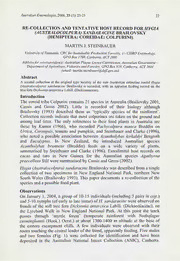
Re-collection and tentative host record for Hygia (Australocolpura) sandaracine Brailovsky (Hemiptera: Coreidae: Colpurini) PDF
Preview Re-collection and tentative host record for Hygia (Australocolpura) sandaracine Brailovsky (Hemiptera: Coreidae: Colpurini)
Australian Entomologist, 2006, 33 (1): 23-25 23 RE-COLLECTION AND TENTATIVE HOST RECORD FOR AYGIA (AUSTRALOCOLPURA) SANDARACINE BRAILOVSKY (HEMIPTERA: COREIDAE: COLPURINI) MARTIN J. STEINBAUER University of Tasmania, CRC for Sustainable Production Forestry, c/- CSIRO Entomology, GPO Box 1700, Canberra, ACT 2601 Address for correspondence: Australian Plague Locust Commission, Australian Government 4 Department of Agriculture, Fisheries and Forestry, GPO Box 858, Canberra, ACT 2601 (email: [email protected]) Abstract A second collection at the original type locality of the rare Australian colpurine coreid Hygia (Australocolpura) sandaracine Brailovsky is recorded, with an apparent feeding record on the tree fern Dicksonia antarctica Labill. (Dicksoniaceae). Introduction The coreid tribe Colpurini contains 21 species in Australia (Brailovsky 2001, Cassis and Gross 2002). Little is recorded of their biology although Brailovsky (1993) described them as 8typically species of the rainforest9. Collection records indicate that most colpurines are taken on the ground and among leaf litter. The only references to their food plants in Australia are those by Kumar (1966), who recorded Pachycolpura manca Breddin on Urtica, Coreopsis, tomato and pumpkin, and Steinbauer and Clarke (1996), who noted a possible association between Acantholybas kirkaldyi Bergroth and Eucalyptus. In New Zealand, the introduced Australian species Acantholybas brunneus (Breddin) feeds on a wide variety of plants, summarised by Steinbauer and Clarke (1996). Extralimital host records on cacao and taro in New Guinea for the Australian species Agathyrna praecellens Stal were summarised by Cassis and Gross (2002). Hygia (Australocolpura) sandaracine Brailovsky was described from a single collection of two specimens in New England National Park, northern New South Wales (Brailovsky 1993). This paper documents a re-collection of the species and a possible food plant. Observations On January 1, 2004, a group of 10-15 individuals (including 3 pairs in cop.) and 5-10 nymphs (of early to late instar) of H. sandaracine were observed on fronds of the soft tree fern Dicksonia antarctica Labill. (Dicksoniaceae), on the Lyrebird Walk in New England National Park. At this point the track passes through 8myrtle forest (temperate rainforest with Nothofagus cunninghamii (Hook.) Oerst.) at about 1300-1400 m altitude at the base of the eastern escarpment cliffs. A few individuals were observed with their rostra touching the central leader of the frond, apparently feeding. Five males and two females (Fig. 1) were collected for identification and have been deposited in the Australian National Insect Collection (ANIC), Canberra. 24 Australian Entomologist, 2006, 33 (1) When handled, they released a pungent, ester-smelling odour, similar to that of other coreids (Steinbauer and Davies 1995). Discussion Records of heteropterans feeding on ferns are rare. The only member of the Pentatomomorpha recorded in Australia on ferns, in the summary by Cassis and Gross (2002), is the highly polyphagous rhyparochromid Remaudiereana inornata (Walker). Only gymnosperms and angiosperms were listed for world Coreidae (including only one Colpurini) by Schaefer and Mitchell (1983). No lower vascular plants were listed for Coreidae in a review of economically important species (Mitchell 2000). Schaefer (1965) regarded the Colpurini as 8primitive9 within the Coreidae. If H. sandaracine can be shown to be monophagous on ferns it would support this view. However, this may be unlikely in view of the wide range of plants used by Acantholybas brunneus in New Zealand (see above). Clearly, more information on the host plants of native Australian Coreidae is required. Fig. 1. Hygia (Australocolpura) sandaracine Brailovsky. (A-B) dorsal and lateral views of adult female, (C-D) dorsal and lateral views of adult male. Scale bar = 5 mm. Australian Entomologist, 2006, 33 (1) 25 Acknowledgements I thank Ben Boyd (ANIC, Canberra) for Fig. 1, Tony Prior (NSW National Parks and Wildlife Service, Dorrigo) for assistance in determining the identity of the host plant, Tom Weir (ANIC, Canberra) for confirmation of the initial species determination and an anonymous reviewer for beneficial revisions to the text. References BRAILOVSKY, H. 1993. A revision of the tribe Colpurini from Australia (Hemiptera- Heteroptera-Coreidae). Memoirs of the Queensland Museum 34: 35-60. BRAILOVSKY, H. 2001. A further contribution to the Australian systematics of the tribe Colpurini (Hemiptera: Heteroptera: Coreidae: Coreinae). Pan-Pacific Entomologist 77: 79-89. CASSIS, G. and GROSS, G.F. 2002. Hemiptera: Heteroptera (Pentatomomorpha). In Houston, W.W.K. and Wells, A. (eds), Zoological Catalogue of Australia. Vol. 27.3B. CSIRO Publishing, Melbourne; xiv + 737 pp. KUMAR, R. 1966. Studies on the biology, immature stages, and relative growth of some Australian bugs of the superfamily Coreoidea (Hemiptera: Heteroptera). Australian Journal of Zoology 14: 895-991. MITCHELL, P.L. 2000. Leaf-footed bugs (Coreidae). Pp 337-403, in: Schaefer, C.W. and Panizzi, A.R. (eds), Heteroptera of economic importance. CRC Press, Boca Raton; 828 pp. SCHAEFER, C.W. 1965. The morphology and higher classification of the Coreoidea (Hemiptera-Heteroptera). Part II. The families Rhopalidae, Alydidae, and Coreidae. Miscellaneous Publications of the Entomological Society of America 5: 1-76. SCHAEFER, C.W. and MITCHELL, P.L. 1983. Food plants of the Coreoidea (Hemiptera: Heteroptera), Annals of the Entomological Society of America 76: 591-615. STEINBAUER, M.J. and CLARKE, A.R. 1996. Revision of the genus Acantholybas Breddin (Hemiptera: Coreidae). Annals of the Entomological Society of America 89: 519-525. STEINBAUER, M.J. and DAVIES, N.W. 1995. The defensive secretions of Amorbus obscuricornis (Westwood), A. rubiginosus (Guérin-Méneville) and Gelonus tasmanicus (Le Guillou) (Hemiptera: Coreidae). Journal of the Australian Entomological Society 34: 75-78.
